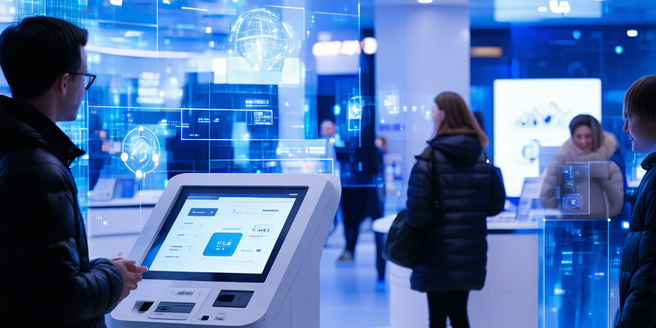
Fintech Disruption
Fintech, or financial technology, is revolutionizing the finance industry with innovations like blockchain, mobile payments, and robo-advisors, making financial transactions more accessible and efficient. Technology is reshaping financial services by reducing costs and enhancing customer experiences through AI, machine learning, and secure mobile banking. Key players in the fintech revolution include startups, tech giants, and traditional banks, all contributing to constant innovation. Fintech challenges traditional banking by offering better rates and increased accessibility, pushing traditional banks to innovate. Regulatory challenges exist as technology outpaces current frameworks, necessitating collaboration for consumer protection and innovation. Future trends in fintech include AI-driven services, blockchain-based finance, and open banking, promising further advancements in the industry.

Virtual Meeting Etiquette
Virtual meetings have become integral to communication in today's digital world, emphasizing the importance of virtual meeting etiquette for effective interaction and productivity. This involves more than turning on a camera; it includes preparation, active listening, and adapting to digital communication. Proper etiquette creates a respectful online environment, reducing distractions and misunderstandings, and enhancing professional image. Preparation is crucial, from setting a clear agenda to choosing the right platform, ensuring technical readiness, and creating a professional environment. Effective communication in online meetings involves speaking clearly, using direct language, and maintaining respectful engagement. Managing technical challenges proactively minimizes disruptions, while engaging participants through interactive tools and feedback ensures dynamic and productive discussions. As remote communication continues to be essential, mastering virtual meeting best practices is key to successful interactions.

Pocket-sized Tech Essentials
Discover the power of mini devices and compact tools for enhancing daily productivity and remote work efficiency. From smartphones and wearable technology to laptops and travel-friendly gadgets, these technological innovations seamlessly integrate into our routines, transforming how we manage tasks, communicate, and remain productive on the go. Embrace the convenience of voice assistants, smartwatches, and ergonomic tools that empower users to handle multiple responsibilities with ease and agility. Whether optimizing home offices with essential gadgets or staying connected during global travels, this rise in tech advancements ensures an effortless blend of work and lifestyle management, making life more manageable and enjoyable wherever you are.

Electric Vehicle Gadgets
Enhance your electric vehicle experience with essential accessories and advanced technology. Must-have charging accessories include portable chargers for on-the-go flexibility, efficient home charging stations, smart cables for cost-effective energy use, and adapter kits for network compatibility. Invest in innovative navigation tools designed for EVs, featuring route optimization, real-time traffic updates, and augmented reality guidance for an efficient, enjoyable journey. Monitor your EV's performance with cutting-edge apps that track battery health, provide maintenance alerts, and encourage eco-friendly driving. Prioritize safety with gadgets like advanced driver-assistance systems, dash cams, and night vision cameras. Experience seamless smart connectivity through IoT-enabled features, personalized infotainment, and wireless updates, transforming EVs into integrated tech hubs. Stay connected, safe, and green with these advancements in electric vehicle technology.

Wearable Fitness Accuracy
Wearable fitness technology, including devices like fitness bands and smartwatches, has transformed how people monitor their health and activities. These gadgets offer features such as step counting, heart rate monitoring, and sleep tracking, providing users with key health insights. Although convenient, the accuracy of these devices can vary due to factors like sensor quality, device placement, and individual physiological differences. Understanding these influences can enhance data interpretation and goal-setting. When comparing different devices, it's important to consider the balance between feature set and complexity, as well as cost. The integration of data analytics plays a significant role, using advanced algorithms to offer personalized health insights and identify potential health issues. Looking ahead, improvements in sensor technology and analytics promise to enhance wearable fitness accuracy, enabling more personalized and comprehensive health monitoring.

Smart Fabrics In Wearable Tech
Smart fabrics, also known as e-textiles, are transforming clothing and personal tech by integrating digital components and electronic circuits into textiles. These innovative fabrics offer functionalities like bodily function monitoring, connectivity, and responsive changes in color or temperature. As technology progresses, smart fabrics are expected to become more accessible, fostering new industry developments. Manufacturing involves embedding technologies such as conductive threads and sensors into traditional fabrics, aiming for durability and comfort. Healthcare applications include non-invasive monitoring of vital signs, providing ease and timely data for patients and professionals. In fashion, these textiles enable customizable designs responsive to stimuli, enhancing personal expression. The sports industry benefits from smart fabrics with detailed biometric tracking and moisture-wicking features to help athletes optimize performance. Future trends promise advancements like self-cleaning textiles, energy-harvesting fabrics, and AI integration, as demand for interconnected and eco-friendly solutions grows.

Smart Plugs For Energy Efficiency
Smart plugs are revolutionary devices that enhance control and monitoring of household appliances and play a significant role in energy management. Connecting to a home's Wi-Fi, they allow remote operation via smartphone apps, enabling scheduling and automation to reduce energy waste. Many smart plugs offer energy monitoring to provide insights into consumption patterns, crucial for making informed energy-saving decisions. Integration with voice assistants like Alexa and Google Assistant adds convenience, bridging the gap to smart home environments. Smart plugs reduce energy bills by automating power management and cutting 'vampire power,' with energy monitoring features that help identify energy-intensive devices. When selecting smart plugs, look for features like Wi-Fi compatibility, energy monitoring, scheduling, compact design, and surge protection. Additionally, integrating smart plugs into a smart home ecosystem enhances convenience and efficiency, with features like programmable timers and motion sensors maximizing energy use. Remote management through apps allows real-time control and synchronization with other smart devices, creating seamless energy-saving routines. Embracing smart plug automation transforms homes into energy-efficient environments while lowering costs and promoting sustainability.

Online Streaming Services
Online streaming platforms have revolutionized the entertainment industry, transforming traditional media consumption by offering instant, on-demand access to a wide array of content. Initially led by services like Netflix, the industry has rapidly evolved, driven by consumer demand for convenience and control. Major players such as Hulu, Amazon Prime Video, and Disney+ have enhanced user experiences through personalized content recommendations, offline downloads, and original programming. This evolution has impacted traditional television and advertising, pushing these industries towards innovative hybrid models. Subscription costs vary across platforms, with value for money becoming a key focus for consumers who are increasingly informed and strategic in their choices. The creation of original content has become a crucial factor in attracting and retaining subscribers, as platforms compete to offer exclusive, high-quality programming.

Securing Data With Remote Work Tools
Remote work has heightened data security challenges, requiring businesses to address unsecured home networks, increased phishing threats, and the use of personal devices lacking corporate safeguards. Organizations must implement robust security strategies, considering vulnerabilities like reduced physical oversight and unauthorized data sharing. Adopting appropriate tools such as data encryption, multi-factor authentication, and VPNs is crucial, alongside evaluating tools for seamless integration and user-friendliness without hampering productivity. Implementing clear policies, regular updates, and strong password practices are vital best practices. Employee training on recognizing threats and secure practices fosters a security-aware culture. Regular security audits and updates are necessary to adapt to evolving threats, ensuring data protection in remote work settings.


